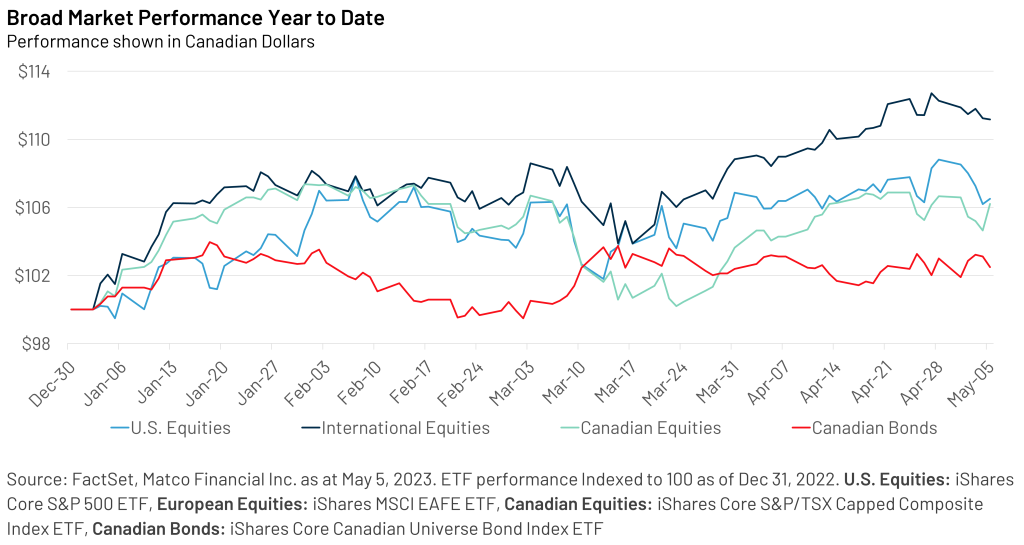
Matco's approach to balanced fund equities
4 minutes read • May 7, 2023

4 minutes read • May 7, 2023

Our firm’s balanced fund mandate is also our largest mandate. Thus, we thought it would be valuable to talk about the asset flows and the features of a balanced fund that matter most to investors—its asset mix.
Over the first quarter of 2023, the investment landscape saw a significant change in its asset allocation, a move to fixed income from equities1. According to IFIC, fixed income gained $6.3 billion in net fund flows.
Long-time investors and seasoned professionals who are moving assets into fixed income are focused on something called a yield curve. They are fixated on the shape of the yield curve and its movement over time. The yield curve is a graph of the current interest rate of a bond and its respective term.
Over the last quarter, the Canadian yield has seen short-term rates stabilize while longer-term rates remain volatile. This longer-term rate movement has presented an opportunity for fixed-income investors to put money to work at more compelling rates than a year ago.
In January, Matco adjusted the asset mix of our balanced mandate from 40% fixed income and 60% equities to 45% fixed income and 55% equities. This adjustment was driven by the more attractive risk-reward relationship of fixed income.
Equities are still the growth driver for an investor over the long term. Using a hockey analogy, finding the right balance between offence (equities) and defence (fixed income) is the name of the game.
As equities continue to make up the majority of the Matco Balanced Fund’s asset mix, we must manage the equity exposure to weather short-term challenges for longer-term gains.
Year to date, equity markets have produced strong first-quarter performance despite intra-quarter volatility. Notably, we saw broad indexes give up their early gains when financial conditions were stressed in mid-March by the failure of regional banks, Silicon Valley Bank and Signature Bank.
The broad markets rebounded powerfully as regulators and the financial industry stepped in to take over the assets of the failed institutions.

Diving a little deeper into equity market fundamentals, let us look at what’s working and what’s of concern today. Any long-time readers of our market insights will have heard us talk about valuations and earnings. In 2023, valuations are mostly in check, but earnings growth is unclear.
| Market | 2021 | 2022 | 2023* |
|---|---|---|---|
| United States | 48.61% | 5.12% | 0.62% |
| International | 49.08% | 4.41% | 5.65% |
| Canada | 85.47% | 7.57% | -4.45% |
Source: FactSet, Matco Financial Inc. as at May 5th, 2023. *2023 Earnings Growth is based on analyst estimates. United States: iShares Core S&P 500 ETF, International: iShares MSCI EAFE ETF, Canada: iShares Core S&P/TSX Capped Composite Index ETF
With uncertainty in broad earnings growth, investing in quality companies is the key to success. We rely on our investment processes to find companies that can improve upon their underlying business despite economic uncertainty.
One of our portfolio holdings is Microsoft, which recently reported its fiscal third-quarter earnings. Not only was Microsoft able to grow its earnings, but it was also able to grow its top-line revenue because of product offerings like Microsoft 365 and cloud services driven by Azure.
Despite all the challenges over the last five years, Microsoft has grown its diluted earnings by a compounded 34.9%2.
To select a company like Microsoft, we employ a factor-based investment process which focuses on quality, momentum, and risk. This process reviews the investable universe and allows us to read through the complexity to build a portfolio of desirable securities.
A balanced mandate is still core to many Canadian investors and contains two main components, the percentage of fixed income and equities. Over the medium term, the risk-reward relationship between equities and fixed income needs to be actively reviewed, and, at times, the weight of each within the balanced mandate requires an adjustment.
As of April 30th, Matco’s Balanced Fund, Series F, was up 4.7% year to date.
To end with our hockey analogy, by adding to fixed income, we are playing some defence in the market. Looking forward, stabilizing economic activity, the path of central bank rates, and the shape of the yield curve may prompt a more offensive stance. Until then, we have an extra defenseman on the ice.
1Source: Investment Funds Institute of Canada. IFIC Monthly Investment Fund Statistics – March 2023. April 25th 2023. https://www.ific.ca/wp-content/themes/ific-new/util/downloads_new.php?id=28352&lang=en_CA.Accessed May 3rd 2023.
2Source: Factset, diluted EPS Growth over 5 years adjusted for the decline in diluted shares outstanding.

delivered to your inbox once a month